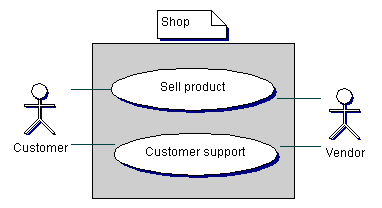The Unified Modeling Language (UML) is a language which can be used to model software
systems. It is is not a programming language or a tool. With UML you can specify (what and how),
visualize, construct, and document artifacts (= deliverables, such as
documents, source code etc).
UML was conceived by Rational Software Corporation and three persons Grady Booch, James Rumbaugh,
and Ivar Jacobson.
UML is maintained by the Object management Group (OMG) and more information can be found at their website:
http://www.uml.org/
This UML reference contains brief summaries of UML elements. All drawings are created with
ArgoUML.
Actor.
An actor is who or what initiates the events with respect to the system.
Actors are simply roles that people or objects play and are indicated by stick figures.

Examples of actors:
People:
- Administrator (system)
- Agent (call center, sales)
- Analyst (security)
- Applicant
- Approver
- Architect (software)
- Author
- Boss
- Buyer
- Caller
- Clerk (sales order)
- Client
- Consumer
- Contractor
- Crook
- Customer
- Designer (database/user interface)
- Developer
- Engineer
- Doctor
- End-user
- Gamer
- Hacker
- Instructor
- Manager (operations/project/sales/trading)
- Member
- Moderator
- Modifier
- Orderer
- Owner
- Participant (non)
- Patient
- Player
- Provider
- Publisher
- Reader
- Registrar
- Researcher
- Reviewer (technical)
- Salesperson
- Scheduler
- Seeker (improvement/information/solution)
- Seller
- Spammer
- Specialist
- Staff (sales)
- Stakeholder
- Student
- Subscriber
- Supervisor
- Supplier
- Trader
- Trainer
- User (login/non-login/site/web)
- Validator
- Vendor
Objects:
- Accounting system
- Application
- Clearing house
- Client
- Computer
- Database
- Development office
- Financial Institution
- Helpdesk
- Message Queue
- Repository
- Sensors
- Server
- Service (delivery, invoicing)
- Shipping
- Store
- System (billing, credit card, reservation)
- Timer
|
|
